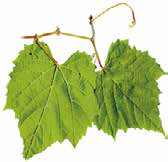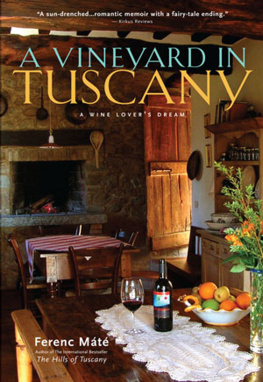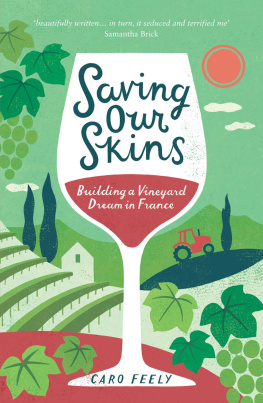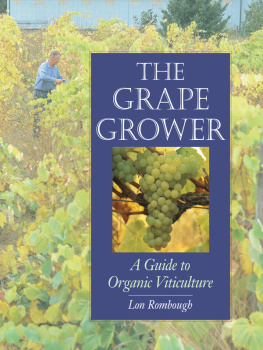
Texas A&M AgriLife Research and Extension Service Series
CRAIG NESSLER AND DOUGLAS L. STEELE, General Editors

Copyright 2014 by Jim Kamas
All rights reserved
First edition
Manufactured in China by Everbest Printing Co. through FCI Print Group
This paper meets the requirements of ANSI/NISO Z39.481992 (Permanence of Paper).
Binding materials have been chosen for durability.

LIBRARY OF CONGRESS CATALOGING-IN-PUBLICATION DATA
Kamas, Jim, 1955 author.
Growing grapes in Texas : from the commercial vineyard to the backyard vine / Jim Kamas.First edition.
pages cm(Texas A&M AgriLife Research and Extension Service series) Includes index.
ISBN 9781-623491802 (flexbound : alk. paper)
ISBN 9781-623492236 (e-book)
1. ViticultureTexas. 2. VineyardsTexas. I. Title. II. Series: Texas A&M AgriLife Research and Extension Service series.
SB387.76.T4K36 2014
634.809764dc23
2014015245
General editors for this series are Craig Nessler, director of Texas A&M AgriLife Research, and Douglas L. Steele, director of the Texas A&M AgriLife Extension Service. Unless otherwise credited, all photographs are from the authors personal collection.
To my familymy loving wife Jacy, my grown kids Nicolas and Rebecca, and our new addition, baby Jonah. You all make my life a joy.
Foreword
What an honor to be able to provide a preview of what will become a must have book for every viticulturist in the state, from the beginning grape grower to that experienced grower looking for answers to everyday problems. Jim draws on his broad experiences to answer questions that potential or current growers did not even know they needed to ask. The book is not only comprehensive but realistic and easy to understand, though very technically accurate. Jim not only shares his philosophy but carries you through all the vital steps needed to be successful in growing grapes. From history, to grape regions in Texas, to rootstocks and varieties, to training and pruning, to controlling diseases and insectsit is all here. He draws on his own trials and tribulations to help others avoid common pitfalls. Along the way he offers commonsense tips on the hows and whys of what it takes to be a successful grape grower serving the wineries of Texas.
I have known Jim since our days as graduate students, and I can assure you that he lives and breathes perennial fruit crops in Texas and has always had that special passion for grapes. He thrives on solving the nagging problems that seem to crop up from time to time. So hang on for not only an exciting but a worthwhile read that will definitely either inspire you to want to be a grape grower or help you overcome the many challenges of growing grapes in Texas.
LARRY A. STEIN
Texas A&M AgriLife Extension Service
Preface
Early in my college career I fell in love first with plants, then later specifically with perennial fruit crops. I loved working in a fruit breeding and variety development project at Texas A&M, and later I was quite content to be a commercial peach grower in Austin County, Texas. Nature and fate had other intentions for me, and after I endured three complete freeze-outs in my orchard, I was given the greatest professional opportunity of my life. In 1988, I was offered, and I accepted, a job as Cornell Universitys extension viticulturist in western New York. My first day on the job, May 9, we had a five-inch snowfall. The first cold front blew in on August 15. I was obviously not in Central Texas anymore. Although I was in culture shock, to my delight I found myself living in a progressive community whose economic viability was centrally focused around grape production. These people had been growing grapes for generations and were among the most warm, receptive people I have ever known. They adopted me, were patient with me, and gave me more than I could ever give back. To this day I have many dear friends in western New York that mean the world to me.
I worked at Cornells Vineyard Lab in Fredonia, on the shore of Lake Erie, and spent the next eight years learning all I could absorb from the incredibly competent and knowledgeable people who surrounded me. Rick Dunst, my research counterpart at the Fredonia lab, quickly became, and remains, my best friend. He and I still talk frequently, we visit each other in New York and Texas as often as we can, and we share the same passion for field viticulture. Bob Pool, Roger Pearson, Wayne Wilcox, T. J. Dennehy, Martin Goffinet, Alan Lakso, Jerry White, Wes Gunkle, and countless others were, and in some cases still are, incredible resources, colleagues, and teachers who had a tremendous, positive impact on me.
One of my greatest teachers was Dr. Nelson Shaulis, arguably one of the best viticultural minds in the world during the twentieth century. I started working for Cornell after Nelson had retired, but there was never a time he was not active in viticulture. I remember being horribly intimidated by him when we first met, and he continued to challenge me at every opportunity for the eight years I lived and worked in New York. I worked hard to try to reach his standards, and I came to understand that his actions and words were simply those of a great teacher and a great mind. His attention to detail, in viticulture and in the written and spoken word, has had a profound effect on me both professionally and personally. He provoked us all to think and to question our own assumptions. On more than one occasion he is known to have challenged his audience by asking the question, Tell me, which is the greater impediment to the advancement of ones viticultural knowledge: failing to answer questions, or failing to question answers?
With that, I encourage each of you to keep that open mind Nelson called us all to maintain. Seek the counsel and advice of many others, but choose the advice you follow carefully. Proceed cautiously and always question not just the how but the why of your decisions. I sincerely hope that the chapters that follow will help you navigate the endeavor you have chosen to begin.
Finally, thanks to the entire team at Texas A&M University Press, especially its editor-in-chief, Shannon Davis, for her support and guidance throughout this project; copyeditor Maureen Bemko, and project manager, Patricia Clabaugh, who shepherded this book through the publications process. Thanks also to Jacy Lewis for her first-rate work on the index.

CHAPTER 1
Why Do You Want to Plant a Vineyard?
ALTHOUGH IT MAY SEEM somewhat rudimentary, it is extremely important for persons or families who want to get into the vineyard business to ask themselves what is behind their desire. Is it because of the pleasure in drinking wine? Is it the social aspects of winery events? Is it the pleasure of working outside and growing things? Grape growing is a venture that requires constant infusions of time, energy, and resources, and, like dancing, timing is everything. A fungicide is the same price if purchased and applied before or after an infection period, but the outcomes will be entirely different.
The most common mistake new and prospective growers make is to underestimate how much time it takes to successfully establish and manage a vineyard of any appreciable size. So, in the beginning, ask yourselves these questions: Are we ready to devote
Next page















